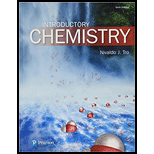
Interpretation:
The formulas for the compounds formed from the given elements that lies on the left and each polyatomic ion that lies on the right are to be written.
Concept introduction:
Metals lie in the left side of the periodic table. Non-metals lie in the right side of the periodic table.
The compounds comprises of positive ions (formed by metals) and negative ions (formed by nonmetals) are called ionic compounds.
Polyatomic ions are composed of a group of atoms having an overall charge.
Following steps to write the formula for the ionic compound
Write the symbol and charge of metal follow by symbol and charge of nonmetal. Charges are determined from the group number in periodic table.
Use magnitude of the charge on each ion as the subscript for other ion.
Reduce subscripts to simpler whole number possible.
Check that sum of the charges of positive ion exactly cancel the sum of the charges of the negative ions.
Want to see the full answer?
Check out a sample textbook solution
Chapter 5 Solutions
INTRODUCTORY CHEMISTRY-W/SEL.SOLN.MAN.
- Fill in the blanks with the smallest integers possible. When gallium (Z=31) reacts with sulfur to form an ionic compound, each metal atom loses ______ electrons and each nonmetal gains_____electronss. There must be _____ gallium atoms for every _____sulfur atoms in the reaction.arrow_forwardWhat are bus? How are ions formed from atoms? Do isolated atoms form ions spontaneously? To what do the termscationandanionrefer? In terms of subatomic particles, how is an ion related to the atom from which it is formed? Does the nucleus of an atom change when the atom is converted into an ion? How can the periodic table be used to predict what ion an element’s atoms will form?arrow_forward10. The element X in a compound was involved in a chemical reaction. After the reaction was completed, which of these would likely happen to the mass of element X? a. It will increase b. It will disappear c.It will be doubled d. It will remain the samearrow_forward
- 7 Which of the following elements will have the fastest chemical reaction? A. Na B. Al C. Si D. P 8 Which of the following elements will have the fastest chemical reaction? A. I B. Br C. Cl D. F Which of the following element's atoms will NOT have an octet of electrons when 9 the atom is ionized? A. Li B. Na C. K D. Rb 10 What is the octet rule? A. All atoms when they chemically react will have only 8 electrons after the reaction is completed. B. Most atoms when they chemically react will try to have 8 valence electrons after the reaction is completed. C. Most atoms when they chemically react will give 8 valence electrons to another atom. D. Most atoms when they chemically react will take 8 valence electrons from another atom. BLIVEWORKSHEETSarrow_forward12. Which element can form ions with different charges? a. Sr b. Cl С. Fe d. Na e. I O a O earrow_forward1. All of the following are used in writing Lewis dot symbols EXCEPT what? a. element symbolb. mass numberc. number of valence electronsd. group number in the periodic table 2. Which is the formula of the compound formed by barium and phosphorus? a. Ba3 Pb. Ba2 Pc. BaP3d. Ba3 P2arrow_forward
- 2. A new fictitious element was discovered. It is a metal named jolmium, J, and it has three valence electrons. If it combines with iodine it forms jolmium iodide. Answer the following questions. a. Is this compound ionic or covalent? b. What is the formula of jolmium iodide? c. What is the charge on the metal J in this compound? d. Explain how you know that is the charge?arrow_forward9. Which pair of atoms would form an ionic bond? a. bromine and oxygen b. chlorine and lithium c. carbon and nitrogen d. sodium and neon e. copper and chromium 15. Using only the periodic table, place the following atoms in order of increasing atomic radius: C, Ba, 0, Ca, and Ge. 21. What types of elements are bonded together to make an ionic compound? Give three examples of ionic compounds. Identify the types of elements that make up the compound in each example. 27. Describe how the physical state of a substance at room temperature depends on the strength of the intermolecular forces between the particles of the substance.arrow_forwardWhich pairs of elements will form ionic compounds? a. lithium and bromine c. calcium and magnesium b. chlorine and oxygen d. barium and chlorinearrow_forward
- What is the formula of the compound that will form between aluminum and sulfur ions? А. AIS В. AlS3 C. Al,S2 D. AIS3 E. Al,Sarrow_forwardWhich type of bond is most common between two nonmetal elements? A. Ionic B. Covalent C. Hydrogen D. Alphaarrow_forwardWhich type of bond is most common between metal and nonmetal elements? A. Ionic B. Covalent C. Hydrogen D. Refractoryarrow_forward
 World of Chemistry, 3rd editionChemistryISBN:9781133109655Author:Steven S. Zumdahl, Susan L. Zumdahl, Donald J. DeCostePublisher:Brooks / Cole / Cengage Learning
World of Chemistry, 3rd editionChemistryISBN:9781133109655Author:Steven S. Zumdahl, Susan L. Zumdahl, Donald J. DeCostePublisher:Brooks / Cole / Cengage Learning Introductory Chemistry: An Active Learning Approa...ChemistryISBN:9781305079250Author:Mark S. Cracolice, Ed PetersPublisher:Cengage Learning
Introductory Chemistry: An Active Learning Approa...ChemistryISBN:9781305079250Author:Mark S. Cracolice, Ed PetersPublisher:Cengage Learning Introductory Chemistry: A FoundationChemistryISBN:9781337399425Author:Steven S. Zumdahl, Donald J. DeCostePublisher:Cengage Learning
Introductory Chemistry: A FoundationChemistryISBN:9781337399425Author:Steven S. Zumdahl, Donald J. DeCostePublisher:Cengage Learning ChemistryChemistryISBN:9781305957404Author:Steven S. Zumdahl, Susan A. Zumdahl, Donald J. DeCostePublisher:Cengage Learning
ChemistryChemistryISBN:9781305957404Author:Steven S. Zumdahl, Susan A. Zumdahl, Donald J. DeCostePublisher:Cengage Learning
 Chemistry: An Atoms First ApproachChemistryISBN:9781305079243Author:Steven S. Zumdahl, Susan A. ZumdahlPublisher:Cengage Learning
Chemistry: An Atoms First ApproachChemistryISBN:9781305079243Author:Steven S. Zumdahl, Susan A. ZumdahlPublisher:Cengage Learning





